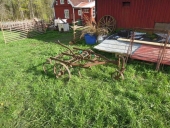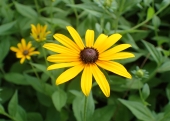posted 6 years ago
You'll never get what's in the seed bank in your soil. That you'll simply have to try and overgrow, as you're trying to do now with the buckwheat.
The management technique you might have success with, depending on scale, is simply to knock down the undesireables manually a bit before they go to seed. Flowering is actually encouraged, because then not only do the pollinators get their crack at them, the organisms expend much of their reserves in flowering, in preparation to go to seed.
I have read in several places where people run their chickens, or their chicken tractors, over the reaped section to pick up any loose seed, which has the benefit of feeding the chooks and manuring the land. If the stubble is grazed beforehand by some handy ruminant that likes that action, then waiting the standard three to eight day larval gestation period will net you a windfall of protein in their waste as well.
By far the best advice that I have heard, generally speaking, having to do with getting rid of problem plants is to change the soil conditions to make it inhospitable for them. If they like poor soil, make it richer. If they prefer alkaline, go acidic. If they like gravelly soil with too much drainage for anything else, perhaps add clay and organic materials to keep it wetter, longer, to nurture weed competition. If they specialise in breaking up hardpan, and you happen to have lots of hardpan, well, I'd actually let them do their thing until there's no more hardpan, and then they'll go away.
Some details about your situation would help, though. I am guessing from the buckwheat that your soil isn't exactly alkaline. Are you just referring to your weeds as blue ribbon because they're so successful, or are you referring to a type of plant? What "weeds" are growing? That could tell us what your soil is like, and what is going on that specific "weeds" are setting up shop.
I made reference above to letting some weeds do their thing in talking about tunnelling, deeply-taprooted pioneer species that break up hardpan. Identifying what your "weeds" are, and what conditions they prefer, could indicate what could be improved in those spots, and looking at how those weeds germinate, grow, and die could suggest what should be left, in the case of dynamic accumulators, nitrogen fixers, and hardpan breaking weed species, until their jobs are done.
Also, what is your assessment of the soil? Have you gotten it tested? What are the perennial problems throughout the season? Is it prone to waterlogging, dessication, cementation? Just plowing might compound any of these issues, especially if those issues were caused by repeated seasonal plowing in the first place. And if it lacks organic matter, waiting until there's some leaf drop before plowing might help that.
But let us know what you decide, and good luck.
-CK
A human being should be able to change a diaper, plan an invasion, butcher a hog, conn a ship, design a building, write a sonnet, balance accounts, build a wall, set a bone, comfort the dying, take orders, give orders, cooperate, act alone, solve equations, analyze a new problem, pitch manure, program a computer, cook a tasty meal, fight efficiently, die gallantly. Specialization is for insects.
-Robert A. Heinlein










 3
3








 1
1




 5
5





 1
1

















